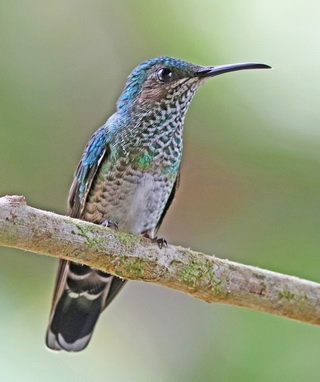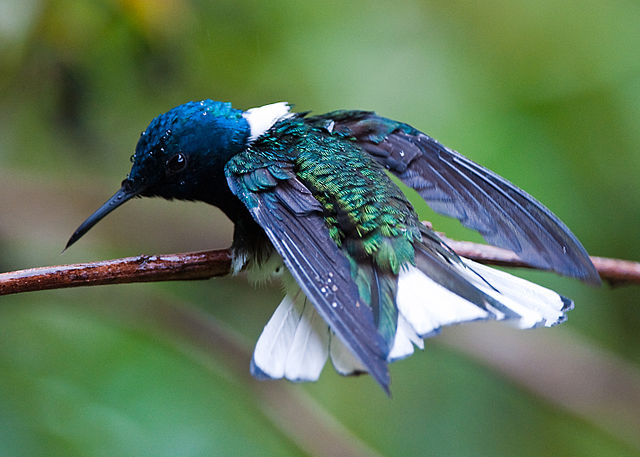Male-like plumage reduces social harassment in females
Most white-necked jacobin females are distinguishable from males by a less bright colour. But 20 percent of the females looks like a male. Jay Falk and colleagues wanted to know why they deviate from the normal pattern.
In hummingbirds, a bird family with more than 300 species, males tend to be more brightly coloured than females. But in one in four species, some females have a male-like plumage, as reported earlier this year by the research group that Jay Falk is part of. Now, he tried to figure out why these females dress like a male. He discovered that it enables them to forage relatively undisturbed. They experience less harassment of both conspecifics and other hummingbirds.
 That hummingbird females normally are less colourful than males – though they are by no means dull compared to many other bird species – is because they raise the young. If they are on or around the nest, a dull colour provides safety: their predators detect them less easily. Hummingbird males have no such tasks and are free to seduce females. To be attractive, they have flashy colours, which females like.
That hummingbird females normally are less colourful than males – though they are by no means dull compared to many other bird species – is because they raise the young. If they are on or around the nest, a dull colour provides safety: their predators detect them less easily. Hummingbird males have no such tasks and are free to seduce females. To be attractive, they have flashy colours, which females like.
White-necked jacobin
But in some hummingbird species, females may have a showy male appearance. The white-necked jacobin, Florisuga mellivora, is an example. About 20 percent of adult females has a shiny blue head, white belly and tail and white spots on the neck like males. Would this confer any benefit?
Perhaps also males prefer a brightly coloured partner, Falk thought at first. But that is not the case, as it turned out when he offered males a choice from several stuffed birds: they prefer a female with normal female plumage.
Harassment
Another possibility is that brightly coloured birds are less likely to be harassed when foraging. Hummingbirds are small animals with a high metabolism that need to consume large quantities of food. So, the birds spend a large part of the day foraging, sucking nectar from flowers. Competition over food is high, and they are quite aggressive around flowers with a high nectar content. Continuously, they are trying to chase each other away.
White-necked jacobin females in female plumage lose out, according to observations. Apparently, they are not impressive. They are more often chased off than brightly coloured animals, both by conspecifics and other hummingbirds. Conversely, they are less aggressive themselves. In addition, they are likely to be sexually harassed more often. Females in male’s outfit, on the other hand, can forage relatively undisturbed.
Accordingly, male-like females were found to visit a place where nectar was offered more frequently than females in female plumage, and they stayed longer. So indeed, male plumage in females is beneficial because it reduces harassment.
A white-necked jacobin female with male plumage does not look exactly the same as a male. When the tail is fanned, a black tail band becomes visible that is wider in these females than in males. They also have some green on the tail.
Brood care
There is another indication that male plumage offers protection against aggression: all young are brightly coloured, while young of animal species usually are camouflaged. Male-like plumage also enables young white-necked jacobins to forage without too much trouble.
So, young females are brightly coloured. As they reach adulthood, 20 percent of females retains that colourful plumage, while the majority, 80 percent, switches to a less conspicuous appearance. Why don’t they all keep looking like males if that increases access to food resources?
Probably because it is still true that during the breeding period a female should not be clearly visible, favouring a less bright colour. Young females don’t have that concern yet.
Willy van Strien
Photos:
Large: white-necked jacobin male. Kathy & sam (Wikimedia Commons, Creative Commons CC BY 2.0)
Small: white-necked jacobin female in female plumage. Joseph Boone (Wikimedia Commons, Creative Commons CC BY-SA 4.0)
Sources:
Falk, J.J., M.S. Webster & D.R. Rubenstein, 2021. Male-like ornamentation in female hummingbirds results from social harassment rather than sexual selection. Current Biology, online August 26. Doi: 10.1016/j.cub.2021.07.043
Diamant, E.S., J.J. Falk & D.R. Rubenstein, 2021. Male-like female morphs in hummingbirds: the evolution of a widespread sex-limited plumage polymorphism. Proceedings of the Royal Society B 288: 20203004. Doi: 10.1098/rspb.2020.3004
